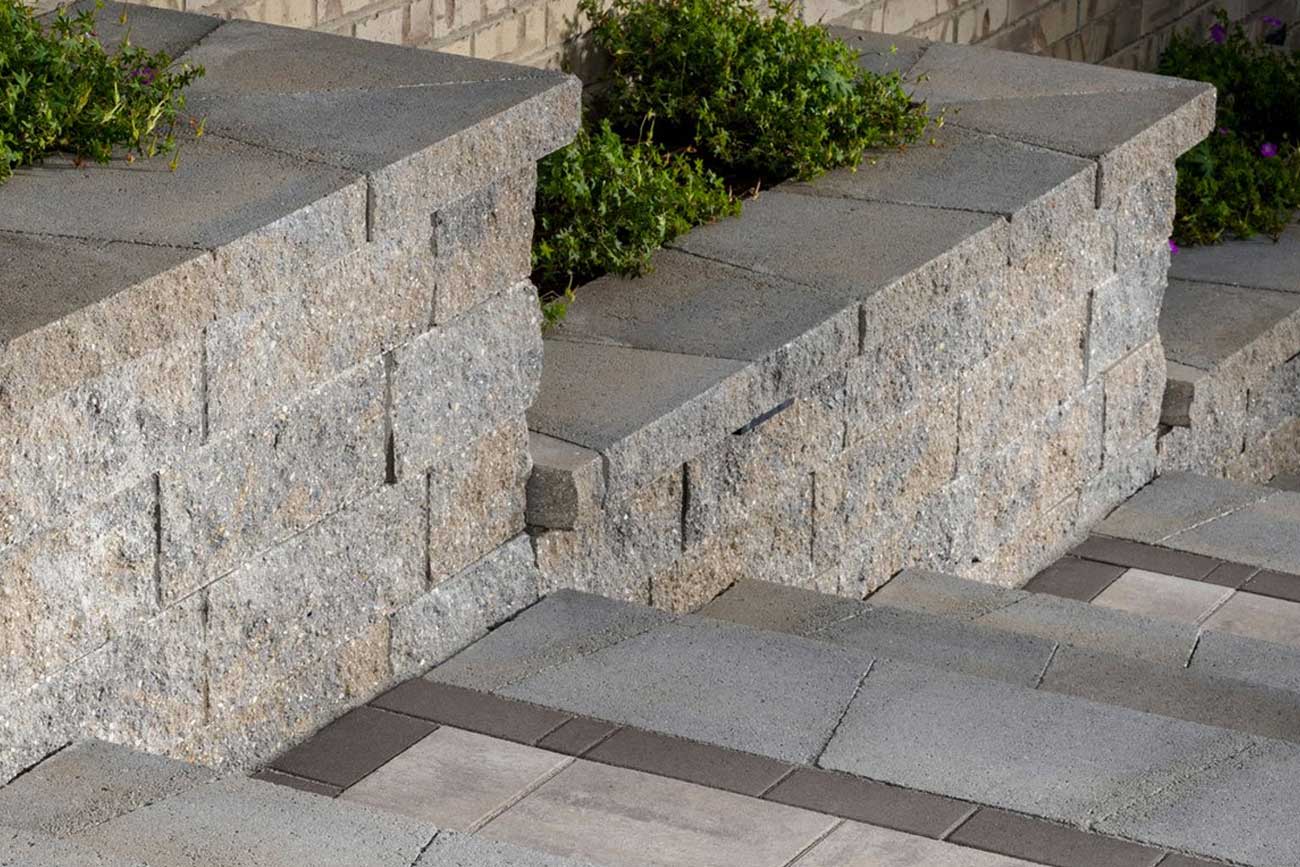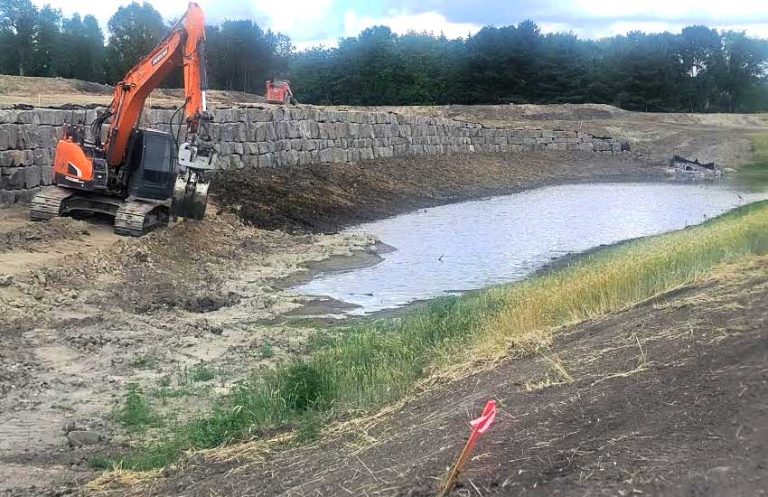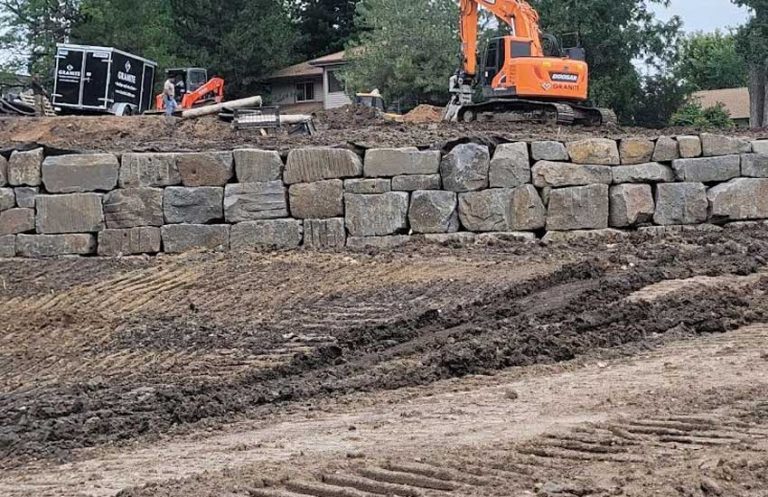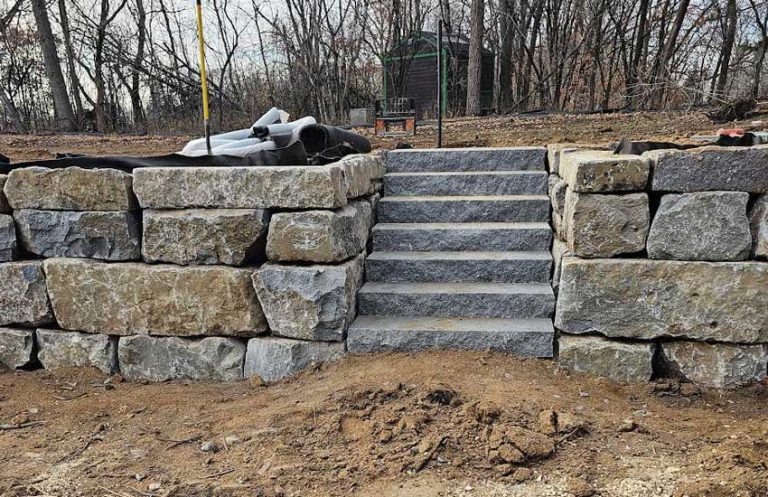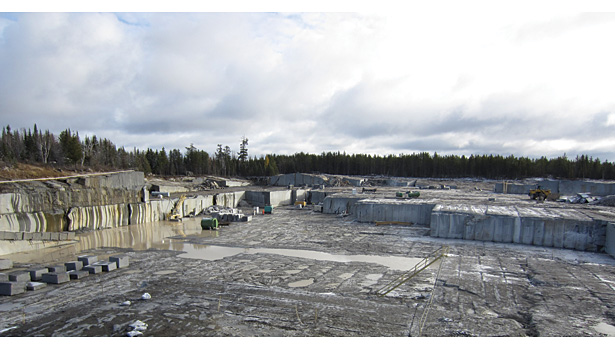Retaining Walls Ideas
When considering retaining wall ideas for your outdoor space, you’ll find a range of options that seamlessly blend functionality with aesthetic appeal. Whether you’re drawn to the timeless look of natural stone or the versatility of modular block systems, each choice brings unique benefits. Imagine incorporating curved walls or multi-level terracing to not only optimize your landscape but also enhance its visual intrigue. And what if you could integrate stone seating into your design? Such elements could transform your space into a cozy, inviting retreat. Curious about more innovative solutions?
Natural Stone Elegance
When considering retaining walls, nothing matches the timeless beauty and durability of natural stone. You’ll find that natural stone not only offers a visually appealing aesthetic but also provides unmatched strength and longevity. Its unique charm lies in its organic textures and varied colors, which blend seamlessly with any landscape.
By choosing natural stone, you’re embracing a material that’s been used for centuries, adding a sense of history and belonging to your outdoor space.
From a technical standpoint, natural stone’s weight and density make it an excellent choice for retaining walls. It can withstand significant pressure from soil and water, ensuring your wall remains stable over time. Additionally, natural stone is highly resistant to weathering and erosion, making it a sustainable option that requires minimal maintenance.
Design-wise, natural stone offers limitless possibilities. You can select from an array of stones like granite, limestone, or fieldstone, each bringing its own unique character to your project. The versatility of natural stone allows you to create anything from a rustic, rugged look to a sleek, modern design.





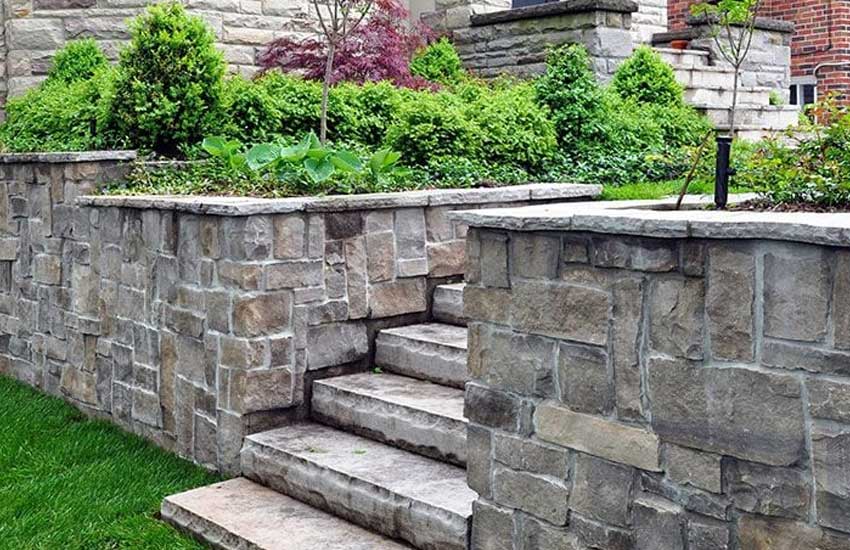
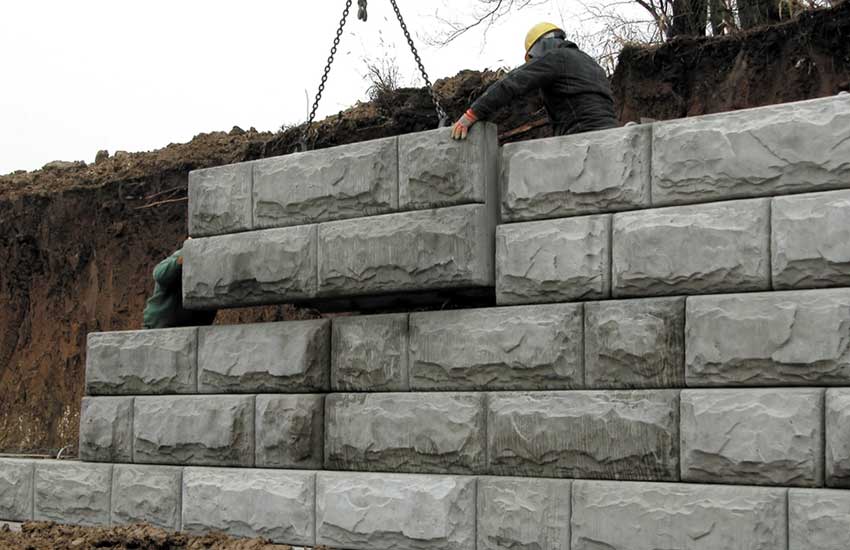






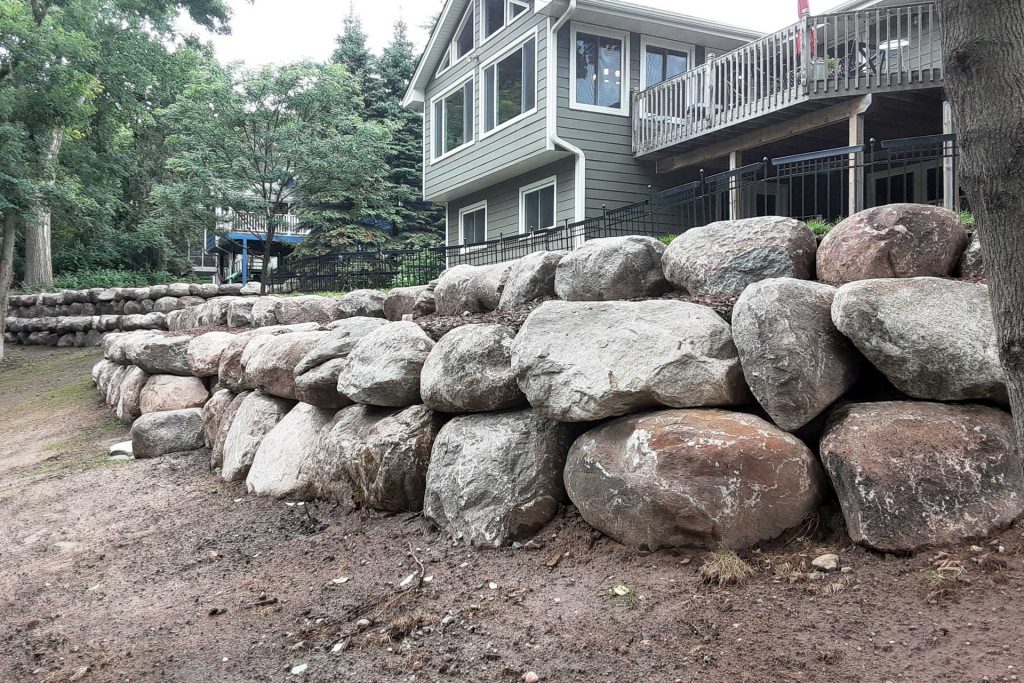
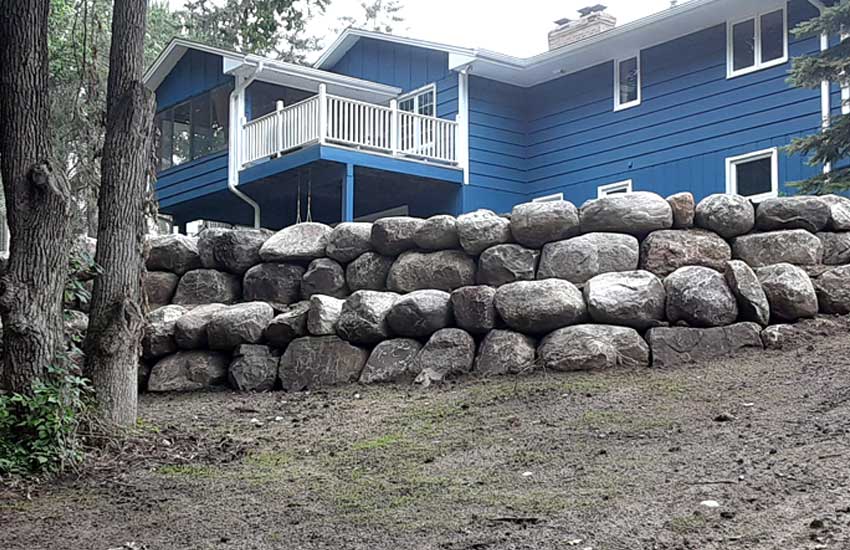
Concrete Block Walls
Concrete block walls offer a versatile and cost-effective solution for your retaining wall needs, combining durability with ease of installation. You can choose from a variety of sizes, finishes, and colors to match your landscape design. Besides their aesthetic appeal, concrete blocks are incredibly resilient, standing up to the elements and requiring minimal maintenance over time.
When planning your retaining wall, consider these three important factors:
| Factor | Description | Benefit |
|---|---|---|
| Material Quality | High-density concrete blocks resist erosion. | Longevity and structural integrity |
| Design Flexibility | Modular blocks allow for creative designs. | Customizable shapes and seamless blending |
| Environmental Impact | Use of recycled materials reduces footprint. | Sustainable and eco-friendly construction |
By opting for concrete block walls, you’re not just investing in a sturdy structure but also contributing to environmental sustainability. Many manufacturers offer eco-friendly options featuring recycled content, which reduces waste and promotes conservation.
To guarantee a successful project, prepare a solid foundation, and follow proper drainage practices. This will help prevent water buildup, which can compromise the structural integrity of your wall. With attention to detail and careful planning, your concrete block retaining wall will not only serve its purpose but also enhance the beauty and functionality of your outdoor space.
Timber Retaining Walls
With their natural aesthetic and versatility, timber retaining walls provide a sustainable and visually pleasing solution for your landscape design needs. Utilizing treated timber, you can create durable structures that blend seamlessly into their surroundings. Timber walls are particularly suitable for gardens and outdoor spaces where a natural look is essential. They offer the added benefit of being relatively easy to install, allowing for a DIY approach if you have the right tools and knowledge.
To guarantee longevity, choose timber that’s pressure-treated to resist decay and insect damage. Cedar and redwood are excellent choices due to their inherent resistance to these elements. When designing your timber wall, consider incorporating tiers or curves to enhance visual interest and provide functional planting areas.
Sustainability is a key advantage of timber retaining walls. By opting for responsibly sourced wood, you contribute to eco-friendly landscaping practices. Recycled and reclaimed timber options can further reduce environmental impact, making your project not only beautiful but also responsible.
Incorporate landscaping fabric behind the wall to prevent soil erosion and ensure proper drainage. By doing so, you enhance the wall’s stability and longevity, creating a harmonious and lasting addition to your outdoor space.
Gabion Walls
Gabion walls, constructed from wire mesh cages filled with stones or other materials, offer a robust and eco-friendly solution for erosion control and landscape design. You’ll find these walls not only practical but also versatile, fitting seamlessly into both natural and urban settings. The stone-filled cages provide excellent drainage, reducing hydrostatic pressure and enhancing stability, making them a top choice for environmentally conscious builders.
When designing your gabion wall, consider the aesthetic and structural advantages. Opt for locally sourced stones to blend with the surrounding landscape and minimize your carbon footprint. The wire mesh can be customized in various sizes and shapes, allowing you to create unique patterns and designs that reflect your personal style while fostering a sense of community with nature.
Installation is straightforward, requiring minimal machinery and labor. You’ll appreciate how the modular nature of gabion walls allows for easy adjustments and extensions as your landscape evolves. Furthermore, these walls are highly durable, resistant to weathering, and require little maintenance—ideal for those who value sustainability and longevity.
Choosing gabion walls means you’re investing in a solution that harmonizes engineering excellence with environmental stewardship. You’re not just building a wall; you’re contributing to a sustainable future.
Modular Block Systems
When considering modular block systems, you’ll find a wide variety of design options that cater to both aesthetic and functional needs.
The installation process is straightforward, making it an attractive choice for those who value efficiency.
Plus, these systems are known for their durability and low maintenance, ensuring a sustainable solution for your retaining wall projects.
Design Options Variety
Modular block systems offer a versatile and sustainable solution for designing durable retaining walls tailored to various landscape needs. You’ll find that these systems not only provide structural integrity but also allow for a wide range of aesthetic possibilities.
Here are four key design options to explore:
- Color Variations: Modular blocks come in various colors, enabling you to match or contrast the wall with your existing landscape features. This flexibility helps create a cohesive and visually appealing environment.
- Textured Finishes: Opt for blocks with different textures, from smooth to rugged, to add depth and character to your retaining wall. Textured finishes can mimic natural stone, enhancing the wall’s integration with natural surroundings while maintaining durability.
- Curved and Straight Walls: Modular block systems are adaptable to both curved and straight designs. Whether you need a gentle arc or a sharp corner, these blocks can be configured to follow the desired contour of your landscape.
- Tiered Walls: For sloped areas, consider tiered retaining walls. They not only manage elevation changes effectively but also offer additional planting spaces, promoting biodiversity and making the landscape more engaging.
Installation Process Overview
Preparing the site and laying the foundation are essential initial steps in guaranteeing a stable and long-lasting modular block retaining wall. Start by excavating the area to create a level base, making sure it’s free of debris and roots. Next, lay a geotextile fabric to prevent soil erosion and improve drainage. This foundation layer is critical for sustainability and longevity.
Once the foundation is ready, begin installing the base course of your modular blocks. Place the first row precisely, as any misalignment can impact the entire structure. Use a level to check each block, and backfill with gravel to enhance stability and drainage. As you build upwards, stagger the joints for added strength and visual appeal.
For taller walls, incorporate geogrid reinforcement between layers. This step is important to distribute the load and ensure structural integrity. Cut the geogrid to the required length and embed it securely within the compacted backfill.
Durability and Maintenance
Ensuring the durability of your modular block retaining wall begins with regular maintenance and monitoring to address any issues before they escalate. A well-maintained wall not only stands the test of time but also enhances the aesthetics of your landscape.
Here’s a guide to keeping your modular block system both functional and visually appealing.
- Inspect for Cracks and Shifts: Regularly check for any cracks or shifts in the blocks. Addressing these early can prevent structural failures and costly repairs.
- Manage Water Drainage: Efficient drainage is essential. Make sure the wall’s drainage system is clear of debris to prevent water buildup, which can weaken the structure over time.
- Clean the Blocks: Use a pressure washer or a gentle scrub with eco-friendly detergent to remove dirt, mold, and algae. This not only maintains the wall’s appearance but also its structural integrity.
- Vegetation Control: Keep plants and roots in check around the wall. Overgrown vegetation can exert pressure on the blocks and disrupt their alignment.
Living Retaining Walls
Integrating living retaining walls into your landscape not only stabilizes slopes but also enhances biodiversity and promotes sustainable design. By incorporating plant life into your retaining structures, you’re creating a habitat that supports local flora and fauna. Choose native plants, as they’re adapted to your region’s climate and soil, requiring less water and maintenance. This approach aligns with eco-friendly practices and fosters a sense of community with nature.
Designing a living retaining wall involves selecting materials like geotextiles, gabions, or modular blocks with integrated planting spaces. These materials provide the necessary support while allowing roots to establish, reducing soil erosion. It’s essential to consider drainage, ensuring excess water doesn’t compromise the wall’s integrity. Implementing a drip irrigation system can efficiently manage water usage, sustaining plant health without waste.
For a cohesive look, match plant varieties to your landscape’s aesthetic. Use cascading plants for a lush, green effect, or mix in perennial flowers for seasonal color. This blend of functionality and beauty transforms retaining walls into living art, fostering a deep connection to your environment. Ultimately, living retaining walls exemplify a harmonious blend of engineering and ecological mindfulness.
Curved Wall Designs
Curved retaining wall designs introduce a dynamic and aesthetically pleasing element to your landscape while seamlessly blending with natural contours. By opting for a curved wall, you can create a sense of flow and movement that a straight wall simply can’t achieve. This design choice not only enhances the visual appeal of your space but also contributes to its sustainability. Curved walls can be more effective at managing soil erosion and water runoff, reducing environmental impact.
To implement a curved retaining wall design, consider these key factors:
- Material Selection: Choose materials like natural stone, brick, or eco-friendly concrete blocks that complement your landscape while offering durability and stability.
- Engineering Precision: Make sure that the wall is engineered to handle the specific load and soil conditions of your site. Proper drainage systems must be incorporated to maintain structural integrity.
- Plant Integration: Softscape your curved wall with native plants and ground covers. This enhances the ecological value and helps the wall blend seamlessly with its surroundings.
- Lighting and Accents: Integrate low-energy lighting to highlight the wall’s curves and create a welcoming ambiance in the evening.
Multi-Level Terracing
Building on the dynamic aesthetics of curved wall designs, multi-level terracing offers a sophisticated approach to managing sloped landscapes while optimizing usable space and enhancing ecological balance. You can create distinct, visually appealing tiers that transform a steep incline into a series of functional, accessible platforms.
By strategically positioning each level, you’ll secure soil erosion and improve water retention, fostering a healthier, more sustainable environment.
To begin, assess your slope’s gradient and soil composition. This information will guide your choice of materials, such as stone, timber, or concrete, to secure structural integrity and longevity. Incorporate drainage solutions like perforated pipes or gravel backfill to prevent water buildup and maintain the stability of your terraces.
Design each terrace with purpose. Whether you’re planting a vegetable garden, installing a water feature, or creating a play area, ensure each level is easily accessible and seamlessly integrated into the overall landscape. Native plants are an excellent choice for your terraced gardens. They require less maintenance, promote biodiversity, and create a cohesive, natural look.
With multi-level terracing, you’re not just reshaping your landscape; you’re fostering a space where functionality meets aesthetic appeal, and sustainability coexists with design innovation.
Integrated Seating Areas
When considering integrated seating areas, you should explore built-in bench options for a seamless and functional design.
Stone seating solutions not only provide durability but also enhance the natural aesthetic of your retaining wall.
Prioritize sustainable materials to make sure your project is both eco-friendly and long-lasting.
Built-in Bench Options
Incorporating built-in benches into your retaining walls not only maximizes space but also enhances functionality and aesthetic appeal. When designing your outdoor space, integrating seating directly into the structure of your retaining walls can create a seamless and inviting environment.
Here are four key considerations:
- Material Selection: Choose materials that complement your existing landscape and are durable. Recycled or locally-sourced materials can minimize your environmental footprint.
- Ergonomics: Guarantee the bench height and depth are comfortable for sitting. Standard bench height is typically 18 inches, with a depth of 15-18 inches.
- Drainage and Maintenance: Integrate proper drainage solutions to prevent water accumulation and use low-maintenance materials to ensure longevity.
- Aesthetic Integration: Design the benches to blend with the wall’s structure, using matching or complementary finishes to create a cohesive look.
Stone Seating Solutions
For a timeless and durable addition to your outdoor space, consider crafting integrated seating areas from natural stone to blend seamlessly with your landscape. Stone seating solutions offer both functionality and aesthetics, creating a harmonious environment that invites relaxation and social interaction.
Utilizing materials like granite, limestone, or fieldstone not only guarantees longevity but also provides a sustainable option, as these stones are often locally sourced and require minimal maintenance.
When designing your stone seating, think about the flow and layout of your space. Curved or straight lines can guide movement and define areas for gathering. By incorporating built-in seating into retaining walls, you optimize space and enhance the structural integrity of your landscape. This method reduces the need for additional furniture, contributing to a cleaner, more cohesive look.
To maximize comfort, consider integrating cushions or wooden slats on the stone surface. This dual-material approach adds warmth and texture, making your seating area even more inviting. Additionally, incorporating native plants around your stone seating can further merge the built environment with nature, fostering a sense of belonging and tranquility.
Stone seating solutions are an investment in both your outdoor space’s beauty and its ecological footprint.
Frequently Asked Questions
How Do I Determine the Height of My Retaining Wall?
First, evaluate the slope and soil type. Check local regulations for height limits. Consider the wall’s purpose and design aesthetics. Confirm sustainable materials and methods align with your community’s values. Consult a professional for precise calculations.
What Is the Cost Comparison Between Different Retaining Wall Materials?
When comparing costs, concrete blocks are generally more expensive than timber but offer greater durability. Natural stone is pricier and requires more skill to install, yet it’s sustainable and aesthetically pleasing, fostering a sense of community.
Are There Any Local Regulations or Permits Required for Building Retaining Walls?
You’ll need to check local regulations or permits for building retaining walls. Compliance guarantees safety, sustainability, and community harmony. Consult your local municipality or building authority to understand specific requirements and integrate eco-friendly practices.
How Can I Ensure Proper Drainage Behind My Retaining Wall?
You can guarantee proper drainage behind your wall by installing perforated pipes and gravel backfill. This design-focused approach controls water flow, preventing erosion and promoting sustainability, aligning perfectly with your community’s shared values of responsible construction.
What Maintenance Is Required for Retaining Walls in Different Climates?
In different climates, inspect for cracks, guarantee proper drainage, and maintain vegetation. Cold climates require frost protection, while wet climates need efficient water management. Regular maintenance guarantees longevity and aligns with sustainable practices for your community’s environment.

